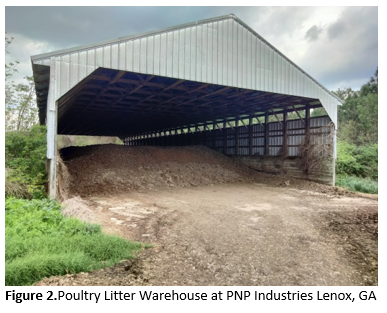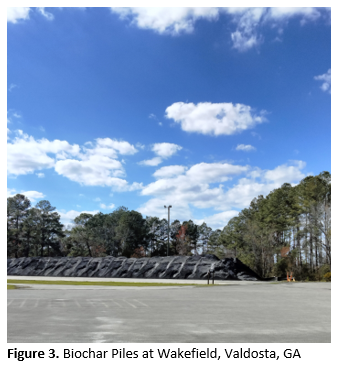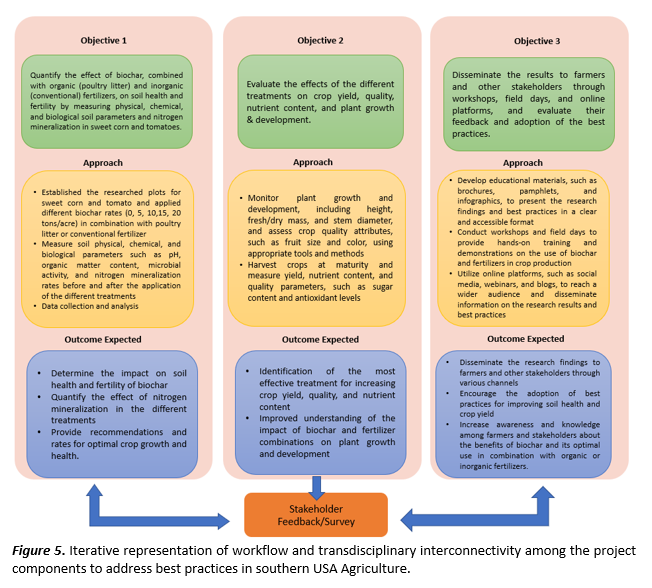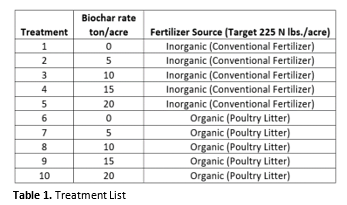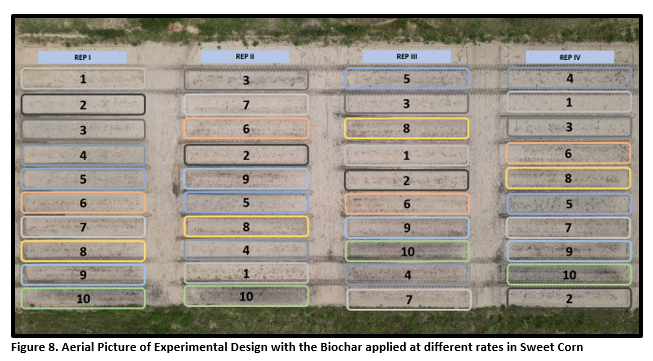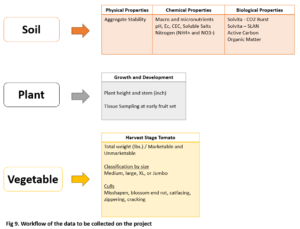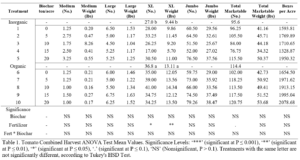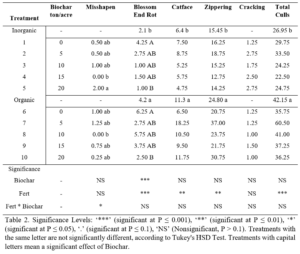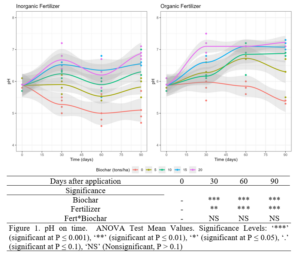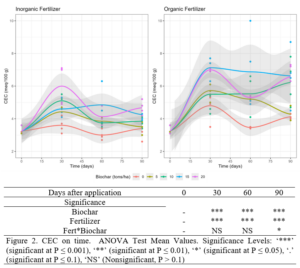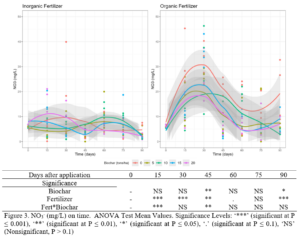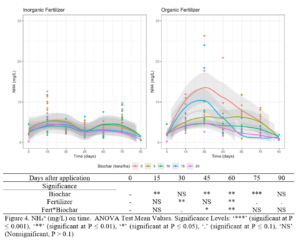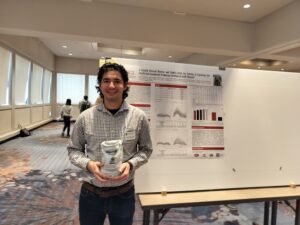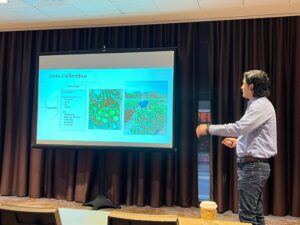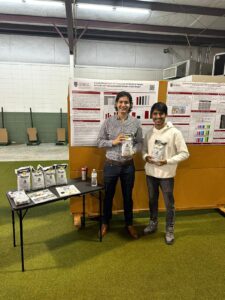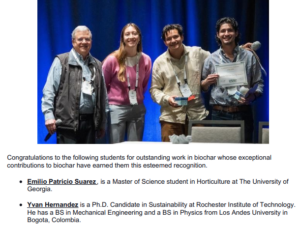Progress report for GS23-275
Project Information
This project aims to assess the effectiveness of biochar, a type of charcoal produced through pyrolysis, on soil health and crop productivity in South Georgia. The study will use biochar at different rates (0, 5, 10, 15, and 20 tons/acre) in combination with organic (poultry litter) or inorganic (conventional) fertilizers. The objective is to quantify the effect of these treatments on soil health and yield using standardized monitoring protocols. The study will also analyze the impact on plant growth and development, including the root system, plant mass, tomato fruit yield and quality, as well as the microbial activity of the soil.
By combining biochar with poultry litter, it is hypothesized that biochar will enhance nutrient retention, thereby reducing nutrient runoff. Additionally, the presence of biochar may also reduce the negative environmental impacts associated with poultry litter alone. The project will evaluate the response of the biochar to soil chemical, physical, and biological properties, including soil health pH, organic matter content, microbial activity, nutrient uptake, and potential for toxic metal accumulation.
The project utilizes locally sourced byproducts, biochar from the paper mill industry, and poultry litter from Georgia's broiler production, the largest commodity industry in South Georgia. The findings from this research will be shared with farmers to enhance best practices, improve crop management, and address environmental challenges. The results are expected to contribute to the sustainability of southern agriculture by improving profitability, sustaining ecological quality and enhancing the quality of life for farmers, ranchers, and rural communities.
Objective 1
Quantify the effect of biochar at different rates in combination with organic (poultry litter) and inorganic (conventional) fertilizers on soil health and fertility by measuring physical, chemical, and biological soil parameters and nitrogen mineralization in the tomato crop.
Approach
- Established the researched plots for tomatoes and applied different biochar rates (0, 5, 10,15, 20 tons/acre) combined with poultry litter or conventional fertilizer, targeting a nitrogen rate of 220 lbs./acre.
- Collect soil samples at the season’s beginning, middle, and end to analyze physical, chemical, and biological properties such as rooting depth, aggregate stability, pH, EC, organic matter content, and microbial activity.
- Collect weekly soil samples of the different treatments to track the nitrogen mineralization.
- Data collection and analysis
Outcome Expected
- Determine the impact on soil health and fertility of biochar at different rates.
- Quantify the effect of nitrogen mineralization in the different treatments
- Provide recommendations and rates for optimal crop growth and health.
Objective 2
Evaluate the effects of the different treatments on crop yield, vegetable quality, plant compounds, plant growth, and foliar development.
Approach
- Monitor plant growth and development (n=10) by monthly measurements of the stem diameter and height.
- At the end of the season, harvest the entire tomato plant (n=10) for each treatment to collect fresh mass, then put samples to dry for dry mass.
- Harvest tomatoes at maturity and measure yield, colors, size, firmness, acidity, lycopene, and carotene content.
- Collect foliar samples to analyze the content of macro and micronutrients on tissue.
Outcome Expected
- Identification of the most effective treatment for increasing crop yield, quality, and nutrient content
- Improved understanding of the impact of biochar and fertilizer combinations on plant growth and development
Objective 3
Disseminate the results to farmers and other stakeholders through workshops, field days, and online platforms, and evaluate their feedback and adoption of the best practices.
Approach
- Develop educational materials, such as brochures, pamphlets, and infographics, to present the research findings and best practices in a clear and accessible format
- Conduct workshops and field days to provide hands-on training and demonstrations on the use of biochar and fertilizers in crop production
- Utilize online platforms, such as social media, webinars, and blogs, to reach a wider audience and disseminate information on the research results and best practices
Outcome Expected
- Disseminate the research findings to farmers and other stakeholders through various channels
- Encourage the adoption of best practices for improving soil health and crop yield
- Increase awareness and knowledge among farmers and stakeholders about the benefits of biochar and its optimal use in combination with organic or inorganic fertilizers.
Cooperators
- (Researcher)
- (Researcher)
- (Researcher)
Research
The first objective is to quantify the effect of biochar, combined with organic and inorganic fertilizers, on soil health and fertility by measuring physical, chemical, and biological soil parameters and nitrogen mineralization in the field. To achieve this, individual research fields will be established for tomatoes and apply different biochar rates (0, 5, 10, 15, and 20 tons/acre) combined with poultry litter or conventional fertilizer (Table.1).
Experimental design
Randomized complete block design with four reps (Figure.8). Plot size 6-inch x 30 ft with 5 ft of an alley. Spacing for tomato 6 ft x 1.5 ft between plants. Each replicate plant is considered an experimental unit (n = 10) (Figure. 8).
The target for all the treatments is 225 N lbs/ acre to supply the minimum nitrogen requirements for tomatoes. For the conventional treatment, a pre-plant application of 10-10-10 will be applied at a rate of 50 N lbs/acre. The remaining 175 N lbs/acre will be supplied through the drip line in 10 weeks, each week providing 17.5 lbs of N to the plants. In the case of poultry litter, a manure laboratory test will be performed to determine the nitrogen concentration available in the batch before the application. The calculations will be completed once the results are obtained, and the 225 N lbs/ acre will be applied to the different biochar treatments once.
The soil’s physical, chemical, and biological properties will be analyzed by collecting soil samples at the season’s beginning, middle, and end of the season to analyze parameters such as rooting depth, aggregate stability, pH, EC, organic matter content, and microbial activity. Additionally, weekly soil samples until the season is over will be taken to track the mineralization of the nitrogen (ammonia and nitrate/nitrite). The data collected will be analyzed to determine the impact of biochar on soil health and fertility and quantify the effect of nitrogen mineralization in the different treatments. The expected outcome is to provide recommendations and rates for optimal crop growth and health.
The second objective is to evaluate the effects of the different treatments on yield, vegetable quality, compounds, plant growth, and foliar development. Plant growth and development, including height and stem diameter, will be measured monthly to achieve this. The fresh/dry mass will be collected at the end of the project. The whole plant will be used for this parameter.
The tomatoes will be harvested at maturity. The right tools and postharvest methods will be considered to assess crop quality attributes, such as fruit size, color, appearance, firmness, lycopene, and carotene content. The expected outcome is to identify the most effective treatment for increasing crop yield, quality, and nutrient content and to improve understanding of the impact of biochar and fertilizer combinations on plant growth and development.
The third objective is disseminating the results to farmers and other stakeholders through workshops, field days, and online. To achieve this, educational materials, such as brochures, pamphlets, and infographics, will be made in a clear and accessible format. Furthermore, in partnership with UGA Extension, workshops and field days will be coordinated to provide hands-on training and demonstrations on using biochar and fertilizers in crop production. In addition, online platforms, such as social media, webinars, and blogs, will reach a wider audience and disseminate information on the research results and best practices. The expected outcome is to disseminate the research findings to farmers and other stakeholders through various channels, encourage the adoption of best practices for improving soil health and crop yield, and increase awareness and knowledge among farmers and stakeholders about the benefits of biochar and its optimal use in combination with organic or inorganic fertilizers.
Preliminary Results Year One
Tomato Yield and Quality
Results from Table 1 indicate that biochar application within the tested ranges does not significantly affect tomato yield. However, a notable finding is the superior performance of organic fertilizer (poultry litter) over inorganic ones, particularly in producing more XL-seized tomato counts and weight. The interaction between fertilizer type and biochar levels shows no significant effect on yield outcomes. Our preliminary results present a viable strategy for organic and inorganic farmers. While the role of biochar requires further investigation, our preliminary findings agree with the literature that biochar won’t directly affect yields in the initial years of application.
The results from Table 2. revealed that while the type of fertilizer significantly impacts the incidence of blossom end rot and total culls, with organic fertilizers associated with higher rates of both, biochar did not uniformly reduce defects. However, there was a significant interaction between biochar and fertilizer type in reducing misshapen, indicating a potential for specific biochar applications to improve fruit morphology under certain conditions. The study's findings underscore the complex interplay between biochar application, fertilizer type, and tomato fruit quality, suggesting that while biochar may offer some benefits in reducing culls, its effectiveness is contingent upon the fertilizer employed.
Soil
Biochar application significantly enhanced several key soil chemical properties, including pH levels (Figure 1.), cation exchange capacity (CEC) (Figure 2.), and nutrient retention, especially at higher application rates. The incorporation of biochar was observed to substantially elevate soil pH by the season's end, attributed mainly to its considerable calcium content. A biochar application rate of (20 tons/acre) notably increased the pH to 6.8 in the inorganic treatment and even higher to 7.2 in the organic treatment when combined with calcium-rich poultry litter. In scenarios without biochar, the sandy loam soils exhibited a decrease in pH levels by the end of the season, indicating biochar's crucial role in counteracting soil acidification. The study also highlighted that a high biochar application rate significantly improved CEC in both inorganic and organic production systems by the season's end, facilitating better nutrient retention in sandy loam soils. Furthermore, higher biochar applications were associated with lower nitrate concentrations (Figure 3.), while the absence of biochar in both treatments led to increased nitrate levels. This pattern was similarly observed with ammonium levels (Figure 4.), where higher biochar applications resulted in reduced concentrations, suggesting that biochar effectively prevents the volatilization of ammonia. The research supports the hypothesis that biochar functions like a sponge, retaining essential nutrients within the soil matrix.
Educational & Outreach Activities
Participation Summary:
Poster Presentations
Suarez, E., Cassity-Duffey, K., Diaz-Perez, J.C., Sintim, H.Y., McAvoy, T. (2024, February). Is Locally Sourced Biochar and Poultry Litter the Solution to Improving Soil Health and Sustainably Producing Tomatoes in South Georgia? Poster session presented at the Southern Region American Society for Horticultural Science, Atlanta, GA.
Suarez, E., Cassity-Duffey, K., Diaz-Perez, J.C., Sintim, H.Y., McAvoy, T. (2023, December). Is Locally Sourced Biochar and Poultry Litter the Solution to Improving Soil Health and Sustainably Producing Tomatoes in South Georgia? Poster session presented at World Soils Day, Tift County Ag Service Center, Tifton, GA. First Place Awarded.
Oral Presentations
Suarez, E., Cassity-Duffey, K., Diaz-Perez, J.C., Sintim, H.Y., McAvoy, T. (2024, February). Is Locally Sourced Biochar and Poultry Litter the Solution to Improving Soil Health and Sustainably Producing Tomatoes in South Georgia? Oral presentation at the Southern Region American Society for Horticultural Science, Vegetable Symposium, Atlanta, GA.
Special Award
Larson Founder's Award. Feb, 2024. at the National Biochar Conference, Sacramento, CA.
The Larson Founders Award is a scholarship honoring the remarkable achievements and dedication of students in the biochar field. This scholarship provides complimentary registration to the North American Biochar Conference, enabling student recipients to enrich their understanding, create meaningful connections, and contribute to the advancement of the industry.
https://biochar-us.org/sites/default/files/blog/US_Biochar_Initiative-February_2024-Newsletter.pdf
Field Day
The field day for on farm demonstration is planned for June 3rd, 2024.
Project Outcomes
Economic Benefits
-
Increased Crop Productivity: Our project has demonstrated the potential for increased crop yields by optimizing soil health and fertility through the application of biochar and fertilizers. Higher yields translate directly into higher income for farmers, improving their economic sustainability.
-
Cost Savings: Utilizing biochar, particularly when combined with locally sourced poultry litter, offers a cost-effective alternative to conventional fertilizers. Given the rising prices of inorganic fertilizers, our approach can significantly reduce the financial burden on farmers, enhancing their profitability.
-
Long-Term Soil Health Improvement: The improvement in soil health boosts crop productivity and reduces the need for future soil amendments. This long-term enhancement of soil quality can lead to sustained economic benefits for farmers by decreasing the need for expensive inputs.
Environmental Benefits
-
Nutrient Retention and Reduced Runoff: Our findings suggest that biochar improves nutrient retention in the soil, minimizing nutrient leaching and runoff into nearby water bodies. This reduces water pollution, a critical environmental challenge in agricultural regions.
-
Carbon Sequestration: Biochar application aids in carbon sequestration, helping mitigate climate change by storing carbon in the soil for extended periods. This environmental benefit aligns with global efforts to reduce atmospheric CO2 levels.
-
Reduced Negative Impacts of Fertilizers: By potentially lowering the reliance on synthetic fertilizers, our project contributes to lessening agriculture's environmental footprint. Reducing fertilizer use decreases the risk of soil and water contamination with harmful chemicals.
Social Benefits
-
Enhanced Food Security: The project's contribution to increased crop productivity supports local food security. With more robust yields, communities can enjoy greater access to fresh, nutritious foods, which is a cornerstone of social well-being.
-
Sustainability Awareness: Disseminating the results of our project through workshops, field days, and online platforms raises awareness among farmers and the broader community about sustainable practices. This educational component fosters a more environmentally conscious approach to farming.
-
Improved Quality of Life for Farmers: Economic benefits, coupled with the promotion of healthier, more resilient farming ecosystems, improve the quality of life for farmers and rural communities. Sustainable practices can alleviate some of the stresses associated with farming, such as the financial pressures of input costs and concerns over environmental degradation.
Throughout this biochar application project in South Georgia, my advisor and I experienced a significant evolution in our understanding and perspectives regarding sustainable agriculture. Initially, our knowledge was primarily theoretical and focused on the potential of biochar to enhance soil health and reduce environmental impacts. However, as we delved deeper into the project, our attitudes toward the practical application of sustainable practices in agriculture became more optimistic.
Our skills in conducting field experiments, analyzing data, and interpreting results improved dramatically. We learned to navigate the complexities of soil chemistry, crop productivity, and environmental sustainability in a real-world context. The hands-on experience of measuring the effects of biochar expanded our technical abilities and provided us with a concrete understanding of how sustainable practices can be implemented effectively. Our awareness of the challenges and opportunities in sustainable agriculture grew as we observed firsthand the impacts of our interventions on soil health and crop yield. We became more attuned to the economic aspects of sustainable farming practices, recognizing biochar's potential to increase farmers' profitability.
Finally, our attitude towards sustainable agriculture transformed from cautious optimism to a firm belief in its viability and necessity. The tangible benefits we observed—improved soil properties, increased crop yields, and potential reductions in nutrient runoff—reinforced our conviction that sustainable practices like biochar application are not just beneficial but essential for the future of agriculture.
